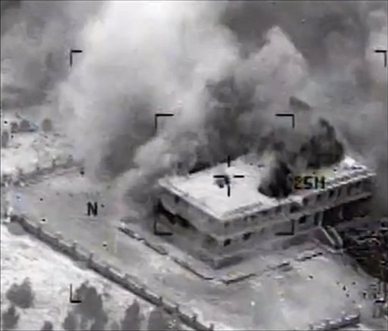Despite all these evidences, the US administration refuses to admit that all these “moderate” groups and ISIL share the same extremist Wahhabi ideology and the takfiri thought
Yusuf Fernandez
Some few days ago, US Congress overwhelmingly approved a Obama administration’s request for authorization to train and arm “rebel” forces in Syria fighting the government of President Bashar al-Assad. According to the US administration, a rebel force of 5,000 fighters should be able to fight against both the Assad government and the terrorist group Islamic State (ISIL). This operation to strengthen the “good terrorists” will be financed with 500 million dollars by US taxpayers.
 According to media, some experts of the US íntelligence community doubt the effectiveness of this plan. They see it as a repeat of the same failed strategy launched by Washington to overthrow President Assad in these past three years. US President Barack Obama himself said in a interview with The New York Times in August that the idea that arming rebels would have made a difference had “always been a fantasy.” Therefore, given that the US Administration insists on this strategy, someone could wonder if the opposition armed groups, which have been unable to defeat the Syrian army when the conditions for the Syrian state were much worse, could now fight both the Syrian army and ISIL and win. Isn’t it a greater fantasy?
According to media, some experts of the US íntelligence community doubt the effectiveness of this plan. They see it as a repeat of the same failed strategy launched by Washington to overthrow President Assad in these past three years. US President Barack Obama himself said in a interview with The New York Times in August that the idea that arming rebels would have made a difference had “always been a fantasy.” Therefore, given that the US Administration insists on this strategy, someone could wonder if the opposition armed groups, which have been unable to defeat the Syrian army when the conditions for the Syrian state were much worse, could now fight both the Syrian army and ISIL and win. Isn’t it a greater fantasy?
Actually, those “moderate” militants seem unwilling to fight the US war against ISIL. Recently, Riad Assaad, leader of the US-supported Free Syrian Army, announced that his group would not join the anti-ISIL coalition that Washington was assembling nor would it participate in attacks on ISIL. He also made it clear once again that the FSA´s goal was not to fight against terrorist groups but overthrow the Syrian government and take over power in Syria.
 Militant groups, including the FSA and the US-backed ‘Syria Revolutionary Front’, have recently signed a mutual non-aggression pact with ISIL in a Damascus suburb. The agreement was brokered by al-Qaeda-affiliated al-Nusra Front and establishes that all groups will respect a ceasefire until they destroy the “Nussayri regime”, a pejorative term used by extremists against the Alawite community. The pact sought to stop the clashes that broke out between militants and ISIL in and around the capital over the previous 45 days.
Militant groups, including the FSA and the US-backed ‘Syria Revolutionary Front’, have recently signed a mutual non-aggression pact with ISIL in a Damascus suburb. The agreement was brokered by al-Qaeda-affiliated al-Nusra Front and establishes that all groups will respect a ceasefire until they destroy the “Nussayri regime”, a pejorative term used by extremists against the Alawite community. The pact sought to stop the clashes that broke out between militants and ISIL in and around the capital over the previous 45 days.
FSA commander Bassil Idriss was recently quoted by Lebanese newspaper The Daily Star as saying that he regularly cooperates with ISIL in attacking Assad government forces along the Syria-Lebanon border. “Fighting at the border crossing in Qalamoun is actually a joint FSA-ISIL operation”, according to the paper. This mutual collaboration is one of the main reasons, along with corruption, for which a large number of American weapons have ended up in the hands of ISIL.
Another group chosen by the US Administration for assistance is Harakat al-Hazm,which has around 7,000 fighters and is linked to Turkey and Qatar. In fact, it has already received US weapons. However, Los Angeles Times recently published an article by a reporter working in Syria, in which he recounted a conversation with two Harakat al-Hazm fighters who admitted the group´s cooperation with al-Nusra Front. “Nusra does not fight us and we actually fight alongside them. We like Nusra”, they said.
 Even worse for the US government, Harakat al-Hazm has denounced airstrikes conducted against the militants of the Islamic State by the US-led coalition. The group has publicly lashed out at the US for launching an offensive against the ISIS on the Syrian territory, AFP reported.
Even worse for the US government, Harakat al-Hazm has denounced airstrikes conducted against the militants of the Islamic State by the US-led coalition. The group has publicly lashed out at the US for launching an offensive against the ISIS on the Syrian territory, AFP reported.
Despite all these evidences, the US administration refuses to admit that all these “moderate” groups and ISIL share the same extremist Wahhabi ideology and the takfiri thought. This explains why so many FSA members are joining the ISIL every day. Western media have reported a growing number of defections of these fighters into ISIL. Of course, the defectors bring the US-supplied weapons with them.
Another problem for the US strategy is that numerous militant factions are fighting each other (and not ISIL). In recent days, there have been fierce clashes among rival groups in the provinces of Idleb and Aleppo. Therefore, US arms will probably be used by these groups to fight against the other ones.
On the other hand, the Syrian opposition is a serious partner for no one as it is deeply divided and seriously weakened by internal disputes relating to money and personal power. Recently, the Syrian National Coalition was rocked by a wave of protest resignations from members of the so-called Supreme Military Council who protested against the “ineffectiveness of reforms” within the coalition. At least ten key coalition members announced their resignation, including the Syrian Revolutionary Front, Sham Legion and the Military Council in Raqqa. Nowadays, no serious analyst thinks that the SNC is a real alternative to rule the country. Its support among the Syrian population is null.
Therefore, the decision to give weapons to these “good” terrorists shows the US administration is still engaged in a regime change game in Syria. This has been openly admitted by US ambassador in the United Nations, Samantha Power, who said that “the training also will service these troops (rebels) in the same struggle they have been in since the beginning of this conflict against the Assad regime”.
Of course, many experts in the US and other Western countries are fully aware of these realities. A report by the Rand Corporation published last September claimed that a nearly half of Obama´s Syrian “moderate rebels” were hard-core extremists whose ideology was indistinguishable from that of the ISIL or al-Nusra Front. The German government has also rejected the idea of handing over weapons to the “moderate rebels”.
The US Administration would have a more serious and effective choice if they were really interested in fighting the terrorism in Syria, Iraq and elsewhere: to cooperate with the Syrian army, which is only real effective force able to stop and destroy ISIL, al-Nusra Front and other terrorist organizations. However, the US has refused to do so. Washington does not want to collaborate with Syria because this country does not accept to submit itself to US control. Certainly, this is not the thinking of most Syrians who care about their independence as much as they oppose US-backed terrorist groups.
Despite all, Washington will have little choice, in the case of a prolonged air campaign, but to have some co-ordination with those fighting ISIL on the ground: the Syrian army, Hezbollah and the Syrian Kurds. Otherwise the US would have to avoid attacking the terrorist group when it is fighting against any of these forces. Maybe Obama does not like this idea but he may find he has no other option.
Disclaimer:
Al-Manar is not responsible for the content of the article. All opinions expressed are those of the writer's not Al-Manar’s or its staff.
